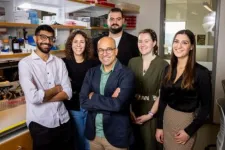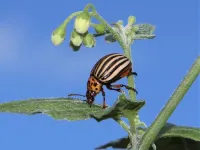(Press-News.org) Hoboken, N.J. October 17, 2024 – When natural disasters strike, social networks like Facebook and X (formerly known as Twitter) can be powerful tools for public communication—but often, rescue workers and government officials struggle to make themselves heard above the general hubbub.
In fact, new research from the Stevens Institute of Technology shows, during four recent major hurricanes, important public safety messaging was drowned out by more trivial social content—including people tweeting about pets, sharing human-interest stories, or bickering about politics. That’s a big problem for officials working to understand where help is needed and to communicate effectively with people impacted by disasters, says Dr. Jose Ramirez-Marquez of the Stevens School of Systems and Enterprises.
“It’s like being at a crowded party—if everyone’s arguing loudly about politics, it’s hard to make yourself heard over the noise,” he explains.
Working with Stevens PhD candidate Yefang Liang, Dr. Ramirez-Marquez analyzed messages posted on X during each of four recent hurricanes—Harvey, Imelda, Laura, and Florence—and identified the clusters of tweets that attracted the most attention and engagement before, during, and after the storms. Their findings, published this week in the International Journal of Disaster Risk Reduction, show that in many cases the topics that generated the most intense online interest were completely unrelated to safety messaging or rescue work.
During Hurricane Harvey, for instance, 24 of the 50 most active topics involved discussion of dogs affected by flooding. By contrast, just seven of the 50 most active topics involved public safety messages. “That’s obviously a problem if you’re a public official trying to ensure people know how to keep themselves safe during a storm,” Dr. Ramirez-Marquez says.
Similar patterns played out during other storms, too. During Hurricane Florence, more than half of high-engagement topics involved either animal-related chatter or political arguments, while just 19 out of the top 50 topics involved rescue or public safety messages. During Hurricane Imelda, meanwhile, debates about climate change accounted for almost one-quarter of all high-engagement topics, drowning out higher-stakes safety messages.
“This really is zero-sum: if conversations about animals or politics are taking up all the oxygen, it’s that much harder for other, potentially more important messages to break through,” Dr. Ramirez-Marquez warns.
The team’s research does suggest some ways that officials can maximize the chances of safety messages reaching a broad audience. Descriptive messaging about storms tends to outperform safety messages, for instance—so combining the two, and weaving public safety notifications or warnings into more descriptive social-media posts, might help to boost the reach of such messages. “It’s also important that officials stay focused during disasters, and don’t inadvertently get drawn into political conversations that could distract from their core messaging,” Dr. Ramirez-Marquez adds.
The reality, though, is that using social media to support safety and recovery efforts in the wake of natural disasters will remain challenging, because many users enjoy engaging with content that doesn’t serve a public safety function. To overcome that, social networks themselves would likely need to step in. Actively amplifying official disaster-related messaging for users in affected communities, for instance, might help ensure that such people get the information they need while still allowing users in other areas to chat freely about unrelated topics.
More broadly, the study highlights the fragility of social-media communities. While the current study focused on the impact of harmless chatter, Dr. Ramirez-Marquez notes, bad actors can also deliberately hijack or distort online conversations by spreading enticing but false information. “As we’ve seen in recent weeks, with the misinformation surrounding natural disasters in Florida, Georgia, and North Carolina, social networks remain highly vulnerable to misinformation,” Dr. Ramirez-Marquez says.
To remedy that, social networks could potentially work to create mechanisms that help users determine who to trust online, or that make it easier to filter out distracting or false information during disasters. “The key here is that the networks themselves will need to take the lead on rebuilding trust online,” Dr. Ramirez-Marquez says. “This isn’t a problem that government officials can solve on their own.”
END
When hurricanes hit, online chatter drowns out safety messaging
Social-media buzz during severe weather events often focuses on politics and pets, Stevens research shows
2024-10-17
ELSE PRESS RELEASES FROM THIS DATE:
Study seeks rapid, paper-based test to detect cancer cells in cerebrospinal fluid
2024-10-17
With time being of the essence for patients facing one of cancer's most dire complications, UCLA researchers are working to create a new test to detect cancer’s spread to the central nervous system on the same day as the doctor’s visit.
When cancer spreads from its primary site, such as the lungs or breast, to the brain or spine, there are well-established methods of treating it. However, when these metastases spread to the cerebrospinal fluid (CSF), a condition known as leptomeningeal disease (LMD), median survival drops to around four ...
Raising happy eaters: Unlocking the secrets of childhood appetite
2024-10-17
URBANA, Ill. — The foundation for healthy eating behavior starts in infancy. Young children learn to regulate their appetite through a combination of biological, psychological, and sociological factors. In a new paper, researchers at the University of Illinois Urbana-Champaign propose a model that explores these factors and their interactions, providing guidelines for better understanding childhood appetite self-regulation.
“When we talk about obesity, the common advice is often to just eat less and exercise more. That’s a simplistic recommendation, which almost makes it seem ...
The Society of Thoracic Surgeons launches two new thoracic surgery risk calculators
2024-10-17
CHICAGO, IL – October 17, 2024 – The Society of Thoracic Surgeons (STS) announces the release of two new risk calculators to inform physician-patient decision-making in thoracic surgery. Engineered using contemporary data from the STS General Thoracic Surgery Database, these interactive tools provide surgeons with accurate, preoperative risk estimations for outcomes of esophagectomy for cancer and pulmonary resection for lung cancer.
The mobile-friendly risk calculators allow surgeons and multidisciplinary ...
FAPESP and CNR plan to launch joint call for proposals in April 2025
2024-10-17
FAPESP representatives visited the headquarters of Italy’s Consiglio Nazionale delle Ricerche (CNR) in Bologna on October 16th to sign a new work plan that will enable the implementation of a cooperation agreement signed by the institutions in December 2023.
The aim is to enable joint funding of research projects in the following areas: Cultures, Inmaterial Heritage, Interdisciplinary Networks; Agri-food and Sustainable Development; Technology and Innovation; and Health and the Environment.
Researcher mobility and ...
Smaller, more specific academic journals have more sway over policy
2024-10-17
DURHAM, N.C. – Scientists don't just want their results to be published; they want them to be published in the most influential journal they can find. This focus on a high 'impact factor' is driven by their concerns about promotion and tenure, but it may be overlooking the important role that smaller publications can play in the advancement of their science.
A new paper, “Role of low-impact-factor journals in conservation implementation,” appearing Oct. 17 in the journal Conservation ...
Medicaid ACOs have not yet improved care for kids with asthma
2024-10-17
In its first three years of operation, Medicaid’s primary care-focused Accountable Care Organizations (ACOs) in Massachusetts showed “no clear evidence of success” in improving asthma care for children, according to research led by the University of Massachusetts Amherst and UMass Chan Medical School-Baystate Health.
The study, published recently in JAMA Pediatrics, compared the asthma care of Medicaid-insured children affiliated with a Medicaid ACO to that of children with private insurance. Senior author Dr. Sarah Goff, a practicing pediatrician and internist ...
New study sheds light on lily toxicity in cats; outpatient treatment may be viable option
2024-10-17
FOR MORE INFORMATION
Michael San Filippo
Senior Media Relations Manager
American Veterinary Medical Association
Cell/Text: 847-732-6194
msanfilippo@avma.org
New study sheds light on lily toxicity in cats; outpatient treatment may be viable option
(SCHAUMBURG, Illinois) October 17, 2024—A study published recently in the Journal of the American Veterinary Medical Association (JAVMA) has revealed new insights into the treatment of cats exposed to toxic lilies, offering hope for pet owners facing this common household hazard.
The study (“Prevalence of acute kidney ...
A new benchmark to recognize the hardest problems in materials science
2024-10-17
Scientists hope that quantum computing will help them study complex phenomena that have so far proven challenging for current computers – including the properties of new and exotic materials. But despite the hype surrounding each new claim of “quantum supremacy”, there is no easy way to say when quantum computers and quantum algorithms have a clear and practical advantage over classical ones.
A large collaboration led by Giuseppe Carleo, a physicist at the Swiss Federal Institute for Technology (EPFL) in Lausane and the member of the National Center for Competence in Research NCCR MARVEL, has now ...
Why do we love carbs? The origins predate agriculture and maybe even our split from Neanderthals
2024-10-17
If you’ve ever struggled to reduce your carb intake, ancient DNA might be to blame.
It has long been known that humans carry multiple copies of a gene that allows us to begin breaking down complex carbohydrate starch in the mouth, providing the first step in metabolizing starchy foods like bread and pasta. However, it has been notoriously difficult for researchers to determine how and when the number of these genes expanded. Now a new study led by The University of Buffalo (UB) and The Jackson Laboratory (JAX) showcases how early duplications of this ...
Key protein for the biosynthesis of defense steroids in solanaceous plants discovered
2024-10-17
The biosynthetic pathway of specific steroidal compounds in nightshade plants (such as potatoes, tomatoes and eggplants) starts with cholesterol. Several studies have investigated the enzymes involved in the formation of steroidal glycoalkaloids. Although the genes responsible for producing the scaffolds of steroidal specialized metabolites are known, successfully reconstituting of these compounds in other plants has not yet been achieved. The project group ‘Specialized Steroid Metabolism in Plants’ in the Department of Natural Product Biosynthesis, led by Prashant Sonawane, who is now Assistant ...
LAST 30 PRESS RELEASES:
American College of Cardiology comments on new dietary guidelines for Americans
American Society of Gene & Cell Therapy and Orphan Therapeutics Accelerator partner to advance and commercialize promising rare disease treatments
One in 14 patients having day case surgery have new or worse chronic pain 3 months after their operation
New study highlights link between eviction rates and gun violence
Heatwaves heat up soil but not toxin levels in rice, study finds
Digital modeling reveals where construction carbon emissions really come from
Turning farm waste into water filters
New study shows how the spleen helps the immune system accept a transplant
New Mayo Clinic study advances personalized prostate cancer education with an EHR-integrated AI agent
Researchers identify novel therapeutic target to improve recovery after nerve injury
Microbes in breast milk help populate infant gut microbiomes
Reprogramming immunity to rewrite the story of Type 1 diabetes
New tool narrows the search for ideal material structures
Artificial saliva containing sugarcane protein helps protect the teeth of patients with head and neck cancer
Understanding the role of linear ubiquitination in T-tubule biogenesis
Researchers identify urban atmosphere as primary reservoir of microplastics
World’s oldest arrow poison – 60,000-year-old traces reveal early advanced hunting techniques
Bristol scientists discover early sponges were soft
New study uncovers how rice viruses manipulate plant defenses to protect insect vectors
NSF–DOE Vera C. Rubin Observatory spots record-breaking asteroid in pre-survey observations
Ribosomal engineering creates “super-probiotic” bacteria
This self-powered eye tracker harnesses energy from blinking and is as comfortable as everyday glasses
Adverse prenatal exposures linked to higher rates of mental health issues, brain changes in adolescents
Restoring mitochondria shows promise for treating chronic nerve pain
Nature study identifies a molecular switch that controls transitions between single-celled and multicellular forms
USU chemists' CRISPR discovery could lead to single diagnostic test for COVID, flu, RSV
Early hominins from Morocco reveal an African lineage near the root of Homo sapiens
Small chimps, big risks: What chimps show us about our own behavior
We finally know how the most common types of planets are created
Thirty-year risk of cardiovascular disease among healthy women according to clinical thresholds of lipoprotein(a)
[Press-News.org] When hurricanes hit, online chatter drowns out safety messagingSocial-media buzz during severe weather events often focuses on politics and pets, Stevens research shows




